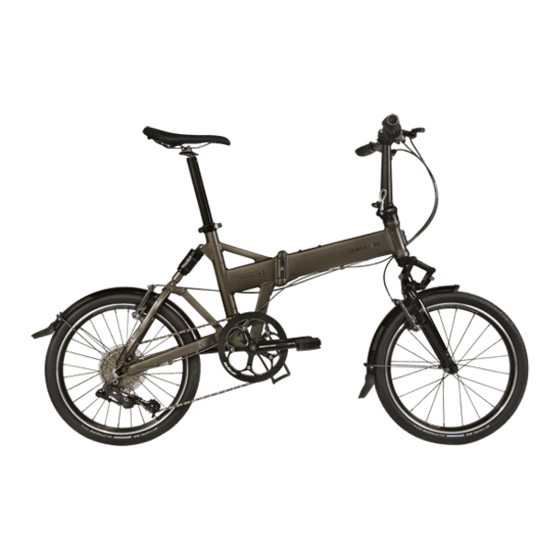DAHON - 2010 Посібник користувача - Сторінка 10
Переглянути онлайн або завантажити pdf Посібник користувача для Велосипед DAHON - 2010. DAHON - 2010 20 сторінок.
Також для DAHON - 2010: Посібник (2 сторінок), Посібник (2 сторінок), Посібник (2 сторінок), Посібник (2 сторінок), Посібник (2 сторінок), Посібник (2 сторінок)

Shifting Gears
Your multi-speed bicycle will have a derailleur
drive train, an internal gear hub drive train or, in
some special cases, a combination of the two.
How a Derailleur Drive Train Works
If your bicycle has a derailleur drive train, the
gear-changing mechanism will have:
A rear cassette or freewheel sprocket
»
cluster.
A rear derailleur.
»
Usually a front derailleur.
»
One or two shifters.
»
One, two or three front sprockets called
»
chain rings.
A drive chain.
»
Shifting Gears
There are several different types and styles of
shifting controls: levers, twist grips, triggers,
combination shift/brake controls and push
buttons. Ask your dealer to explain the type of
shifting controls that are on your bike, and to
show you how they work.
A downshift is a shift to a "lower" or "slower"
gear, one that is easier to pedal. An upshift is
a shift to a "higher" or "faster", harder to pedal
gear. To select a gear that will make pedaling
10
easier on a hill, make a downshift in one of two
ways: shift the chain down (the gear "steps" to
a smaller gear at the front) or shift the chain up
(the gear "steps" to a larger gear at the rear.)
So, at the rear gear cluster, what is called a
downshift actually moves the chain up to a
larger gear. The way to keep things straight is
to remember that shifting the chain in towards
the centerline of the bike is for accelerating and
climbing and is called a downshift. Moving the
chain out or away from the centerline of the
bike is for speed and is called an upshift.
Whether upshifting or downshifting, the bicycle
derailleur system design requires that the drive
chain be moving forward and be under at least
some tension. A derailleur will shift only if you
are pedaling forward.
Shifting the Rear Derailleur
The right shifter controls the rear derailleur.
The function of the rear derailleur is to move
the drive chain from one gear sprocket to an-
other. The smaller sprockets on the rear wheel
gear cluster produce higher gear ratios. Pedal-
ing in the higher gears requires greater pedal-
ing effort, but takes you a greater distance with
each revolution of the pedal cranks. The larger
sprockets produce lower gear ratios. Using
them requires less pedaling effort, but takes
you a shorter distance with each pedal crank
revolution. There are two set screws or limit
screws on the rear derailleur body that limit the
travel of the rear derailleur. Tightening the rear
derailleur high gear adjustment screw keeps
the chain from shifting off the small (high) gear
that is on the rear axle. Tightening the rear
derailleur low gear adjustment screw keeps the
chain from shifting off the large (low) gear into
the rear wheel. Moving the chain from a smaller
sprocket of the gear cluster to a larger sprocket
results in a downshift. Moving the chain from
the smaller sprocket on the chain rings to a
larger sprocket results in what is called an
"upshift." In order for the derailleur to move the
chain from one sprocket to another, the rider
must be pedaling forward.
Shifting the Front Derailleur
The front derailleur, which is controlled by the
left shifter, shifts the chain between the larger
and smaller chain rings. Shifting the chain onto
a smaller chain ring makes pedaling easier (a
downshift). Shifting to a larger chain ring makes
pedaling harder (an upshift). There are 2 (two)
adjustment screws on the front derailleur: one
is to limit the travel of the front derailleur so
that the chain can be shifted upwards towards
the larger, higher or harder to pedal gears but
will not allow the chain to "overshift." The other
screw limits the travel of the front derailleur
towards the smaller or easier-to-pedal chain-
wheel. By limiting travel, it prevents the chain
from "undershifting" and keeps the chain from
falling off the chainwheel onto the frame.
